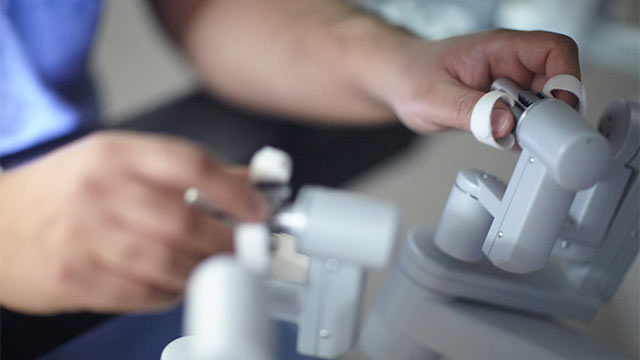Minimally Invasive and Robotic Procedures

In the past, surgery was always thought to be a major undertaking. Most procedures were followed by days in the hospital, followed by weeks of recuperation at home. Luckily today, minimally invasive procedures (also called endoscopic procedures) offer surgical options that are much more convenient—and just as effective. You can usually go home the same or next day after a minimally invasive procedure. With minimally invasive techniques, incisions are smaller and there’s decreased blood loss, lower risk of infection, reduced scarring, less pain, and often a decreased need for pain medication, than with traditional open surgery. These benefits translate into a shorter recovery time and a quicker return to normal life.
Advances in video imaging and endoscopic techniques have brought us robotic surgery. This approach allows our surgeons to operate from a console with master controllers that maneuver robotic arms. We use high-definition 3D images to visualize the surgical space, allowing our surgeons to gain greater visibility than with traditional surgery.
At Mount Sinai, we have extensive experience with both of these types of stable, less invasive approaches. We also have access to the Mount Sinai Robotics Institute (MSRI) at the Icahn School of Medicine at Mount Sinai, which conducts research and gives us access to the very latest equipment and techniques.
Minimally Invasive Procedures
At Mount Sinai, we use the most advanced equipment for minimally invasive procedures, including GreenLight™ laser and Holmium laser treatments. We perform a variety of special minimally invasive surgeries, including the following:
- Arterial embolization sends solid particles or a special liquid through the renal artery to block the flow of blood into the tumor, starving it of oxygen and causing it to shrink or die.
- Bilateral axillo-breast approach (BABA) uses a robotic approach to treat larger thyroid glands and select cases of thyroid cancer with minimal scarring.
- Flap breast reconstruction uses robotics to separate and rotate forward the latissimus muscle to create a new breast mound on the chest wall.
- Heller myotomy treats achalasia, a disorder of the esophagus.
- Laparoscopic colectomy removes the colon.
- Laparoscopic distal pancreatectomy removes the pancreas.
- Laparoscopic gastrectomy removes the stomach.
- Laparoscopic hepatectomy removes all or part of the liver.
- Laparoscopic hyperthermic intra-peritoneal chemotherapy (HIPEC) delivers chemotherapy to the stomach
- Laparoscopic lymph node biopsy enables us to diagnose a lymphoma
- Laparoscopic small bowel resection removes the small bowel
- Laparoscopic total proctocolectomy with ileoanal pull-through removes the colon and creates a temporary ileostomy stoma
- Laparoscopic transhiatal esophagectomy removes the esophagus.
- Microwave ablation destroys tumors using controlled heat at higher temperatures than radio waves.
- Minimally invasive esophagectomy removes the esophagus.
- Paraesophageal hernia repair repairs hernias.
- Percutaneous radio frequency ablation involves inserting image-guided needles to deliver radio waves that can shrink tumors through heat.
- Transanal Endoscopic Microsurgeries (TEM) allows us to treat benign and malignant polyps.
- Transoral Endoscopic Thyroidectomy Vestibular Approach (TOETVA) helps treat benign thyroid disorders without scarring.
- Transurethral resection of a bladder tumor (TURBT) allows us to remove the bladder.
- Transaxillary endoscopic thyroid surgery uses only one incision to perform a partial thyroidectomy for benign thyroid diseases or small thyroid cancers.
In addition, we use minimally invasive procedures to address a variety of conditions, including:
- Bariatric concerns
- Benign and cancerous colorectal conditions
- Benign prostate hyperplasia (BPH)
- Complete (radical) or partial removal of the kidney
- Compression fractures
- Degenerative/arthritic disc disease and back pain
- Diaphragmatic hernia
- Gastrointestinal tract conditions
- Kidney stones
- Pleuraltumors
- Removal of tumors of the larynx, pharynx, thyroid, parathyroid and skull base, while preserving voice and swallowing capabilities
Robotic Surgery
At Mount Sinai, we have the most advanced equipment, including three da Vinci robots, which allow for sharper visualization as well as better dexterity for our surgeons to work in a smaller space. We perform the following robotic surgical procedures:
- Bilateral axillo-breast approach robotic thyroid surgery (BABA) lets us remove large benign thyroid disorders and advanced thyroid cancers.
- F.A.S.T. robotic partial nephrectomy helps us remove a kidney tumor and reconstruct the kidney.
- Partial nephrectomy is a treatment for renal cell carcinoma.
- Robotic Hernia Surgery
- Robotic cystectomy and urinary diversion treats bladder cancer without harming the uterus and vagina.
- Robotic pyeloplasty treats ureteropelvic junction (UPJ) obstruction.
- Breast reconstruction rebuilds a breast after a mastectomy.
We also use robotic surgery to address the following conditions:
- Achalasia
- Adrenal gland conditions
- Benign and cancerous colorectal conditions
- Cancers, low-grade tumors, and benign disorders
- Esophagus conditions
- Gastroesophageal reflux disease
- Gynecologic conditions
- Hyperhydrosi s reversal
- Kidney conditions
- Myesthenia gravis
- Oral and throat (head and neck) cancers
- Sleep apnea
- Thoracic conditions (esophageal and lung)
- Urological disease (adrenal, bladder, kidney and prostate)